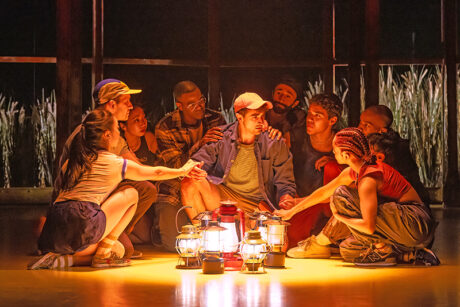
ETC Electrifies the Wonders of Illinoise on Broadway
Broadway’s offbeat sweetheart is Illinoise, an awe-inspiring dance musical derived from the 2006 Sufjan Stevens album of the same name. The four-time Tony nominated show, created by choreographer Justin Peck (who won Illinoise the Tony for Best Choreography), is lit by Peck’s longtime collaborator Brandon Stirling Baker. Illinoise runs on an Eos Ti, programmed by Jeff Englander. Stirling Baker’s joyous lighting design earned him a Tony nomination for his Broadway debut.
It’s a production over a decade in the making. Peck and Stirling Baker’s long-running artistic partnership began with Year of the Rabbit at the New York City Ballet, a performance set to the music of Sufjan Stevens’ 2001 album Enjoy Your Rabbit. The pair quickly bonded over a shared love of Stevens’ music, the Illinois album in particular. “We both grew up listening to this album,” says Brandon Stirling Baker. “Justin and I have been geeking out over Illinois as a project for 14 years now.”
After years of incubation, Illinoise first took physical shape at Bard Summerscape in 2022. “It was a very abstract piece,” says Stirling Baker. “It was extremely weird, but we loved it. We were very into creating a so-called musical without following the traditional jukebox structure.” From there, the show landed at the Chicago Shakespeare Theatre. “I think the show really found itself in Chicago,” programmer Jeff Englander says—fitting for a production whose best-known number is named after the city. After a month in Chicago, Illinoise plowed ahead to the Park Avenue Armory in New York City. “The Armory is one of the coolest spaces in America,” says Stirling Baker. “It’s 400 feet deep, 80 feet tall — It has the feeling of a football stadium, but for the arts, you know? It has always been a bucket list venue for Justin and me because you can really do anything in there.”
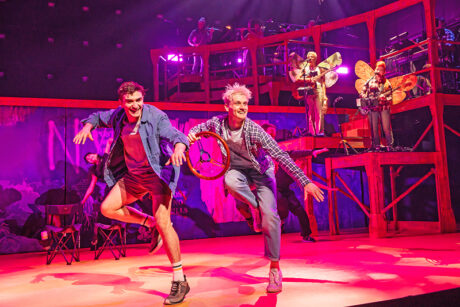
Venue Change
Moving an ever-evolving musical between wildly different venues on a tight schedule could have been a programming nightmare without the right tools. Luckily, Englander’s extensive use of Augment3d made transfers a breeze: “Thank God for 3D visualizing! Augment3d was extremely important to how I transferred the show from one venue to the next. The 3D makes the focus nearly perfect, so all we had to do was mess with the beam parameters a bit to make things look good.”
After the news arrived that Illinoise was heading to Broadway, opening night came only three weeks later. “Justin and I come from the world of ballet, where we’ll do tech in the morning, dress rehearsal in the afternoon, and open that night, which is very normal for us. This was like doing a Broadway musical on a dance schedule,” Stirling Baker jokes.
Englander was in the middle of another job when the transfer was to take place, so he entrusted his show file to David Arch to transfer to the St. James Theatre. “I was the programmer on the first Broadway show that Brandon worked on as an assistant, and now this is his first Broadway show as a designer, so it was very full circle,” says Arch. “Jeff did a great job, so it was really just a matter of me refining it and working in the new equipment.”
When questions arose about upgrading certain equipment in the transfer, the team opted to keep things simple. “We come from very humble beginnings and the show only got smaller and nimbler as we went along,” says Stirling Baker. “We’re just a show with music, dance and light, and I’m very proud that that was enough. Our very first iteration of the show at Bard had a bigger light plot than the Broadway version.”
From Bard to Broadway, Eos Ti remained the console of choice. “I love that the Ti has a row of programmable hard keys that are horizontal. Because as it turns out, my hands happen to be horizontal as well,” says Englander. Arch puts it simply: “Sitting at the Ti feels like coming home.”
“What’s really exciting is that even with so much electric energy and light, the cueing is very simple. For me, it was super important that the choreography dictated how the lighting cues would happen. For every song in the show, a lot of the cues and lighting ideas in general are inspired by the choreography,” says Stirling Baker.
Supporting the Storytelling
The show is structured around a circle of storytellers, with each song telling its own unique tale. Each number was an opportunity for Stirling Baker to create a fully contained world with its own lighting logic: from the graphic, Lichtenstein-inspired colors of “The Man of Metropolis” to the stark, Hitchcockian shadows of “John Wayne Gacy, Jr.” All this dynamism was accommodated by High End Systems’ SolaFrame Theatre fixtures. With a 15,000 lumen output, fixed and indexing gobo wheels, animation effects, and a wide zoom range, SolaFrame Theatre makes for a dynamic, feature-packed fixture—all with the silent operation that a theatrical environment requires.
An important facet of the show’s lighting design comes from the last place that one would expect. “As a lighting person, the first thing that you notice when you walk on stage is that the entire floor is bright yellow. My immediate thought was how on earth do you deal with a yellow floor?” says Arch. “Brandon used it as a giant bounce. He would take a light and hit that yellow floor and it would illuminate the entire cast. It blew me away.”
This result is a culmination of lots of experimentation from Stirling Baker. “I’m a huge fan of playing with the way that light reflects off the floor and the way it can light a full stage. When people see the show, it’s a cool surprise that a lot of the light that we see, even on the dancers, is very indirect. In my opinion it’s more interesting, it feels less typical.” The perfect vessel to deliver this effect was the show’s trusty Source Four LED Series 2 fixtures with the Lustr array. “Our four Series 2s are the huge workhorse for all of our reflected light,” he says. “They’re beautiful lights, and so reliable.”
Stirling Baker closes Illinoise with a lighting cue that he considers an offering to the audience, one that inspires viewers to tell stories of their own. “I think there’s something really beautiful about a light cue, a lighting image, that can feel like an offering to its audience.” For Stirling Baker, the offering that turned him into the designer he is today came in the form of an ETC console. “I was first introduced to the world of lighting when I was 13 years old, and ETC equipment was there from the very beginning. ETC has always been a part of a designer’s introduction to light, not only for myself, but for so many people who are coming up behind me.”
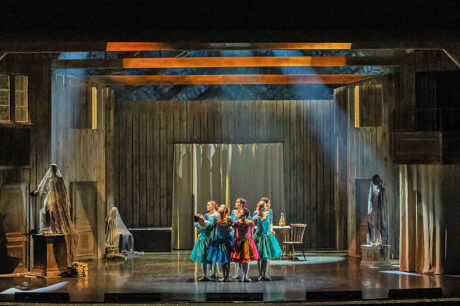
Robe Makes a Positive Impression at the Baltic Opera Gdansk
The award-winning Opera Baltycka (Baltic Opera) in Gdansk, on Poland’s stunning north coast, has invested in new Robe lighting fixtures with the purchase of 18 TX1 PosiProfiles and four PAINTES which have been installed into its current building. The opera house has a colorful and varied history and was originally built and opened as an equestrian sports hall in 1915. It went through various other iterations, and the first opera was performed there in 1950, and since then the building has undergone several renovations. While the cozy 476-seat capacity makes it Poland’s smallest opera hall, The Baltic Opera has a formidable reputation for excellence, high production values and world class performances.
Lighting Specialist Marek Lebida has been working full time at the Opera since the Robe fixtures arrived last year, supplied by Robe’s Polish distributor Prolight, and delivered via their local partner, Gdansk-based Grupa Profit. Lebida was inspired to make entertainment his career by his father who worked as a lighting master at this same Opera House, however he started on the other side of the stage as a ballet dancer. He used to dance in the Opera House when at school, so joining the team was like a homecoming. Immediately before then, he worked on shows and live events for a local rental company and as a freelance lighting designer and director.
Baltic Opera is a producing house with its own company (opera singers and ballet dancers) and orchestra, staging around 10 shows a month, primarily opera and ballet, of which four will usually be new works and the rest revivals. They also stage special performances for occasions like New Year.
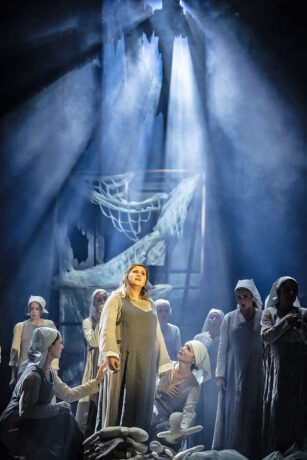
Move to Reliability
Before the new Robe luminaires arrived, there were other moving lights in the house, explained Baltic Opera’s Head of Technical, Krzystof Materny, but these were getting old and unreliable. During Covid, they started thinking about ways to reduce power consumption—with a goal of using 20-30% less—part of which would be achieved by steadily transitioning to more LED lighting fixtures in the house rig. The decision to purchase the Robe luminaires followed a demonstration by Prolight and consultations with some of their regular lighting designers including Lebida, as he had specified Robe regularly for multiple projects as a freelance LD. Several others working at the Opera had also used Robe when they rented in additional fixtures as needed for shows, so all were aware that their own lighting needed to be updated and the time was right for a change.
The TX1 Posi Profile’s CRI was crucial in the choice, stated Lebida, to get those nice natural flesh tones. “We set up real-life stage tests and compared the skin tones of the TX1s with some other products including the Opera’s existing profile moving lights, and the TX1 just killed it.” “There was really no comparison. So, after that everyone was convinced, we were making the right decision,” confirmed Lebida. He noted that even the more traditional ‘tungsten warrior’ lighting professionals working at the opera… saw that these LED fixtures looked fantastic.
Lebida admits that on one show he was watching where he saw the light source but not the device and thought it must be a tungsten fixture, so authentic is the emulation. The decision to purchase was made by a team of five including Materny and Baltic Opera Technical Director, Magda Zablotny. In addition to all the creative and technical reasons for choosing Robe, they were also reassured by Warsaw-based Prolight’s great industry-wide reputation, so were confident that the all-important support would be there whenever needed.
Confined Solution
Designed to operate as a full moving head or a static but repositionable profile, the TX1 PosiProfile can also function in extremely confined spaces where crew access is problematic or where movement options are limited or not required as it doesn’t physically move during pre-use calibration. With the TX1s now installed on four house bars over the stage with two on the floor, it has made a massive difference to how shows can be lit, bringing a new vibrance and vitality to the stage and dramatically increasing the audience experience for all productions.
Lighting for most of the opera productions is designed by in-house LD Maciej Kaczerski, and Marek Lebida lights all the special shows, concerts and one offs.
The four PAINTES are fitted into two recesses either side of the auditorium and are used for front cross lighting, replacing the previous spot moving lights in the same positions. They are seriously quieter than the old fixtures, which is always a bonus for opera and ballet performances where audiences tend to be extremely conscious of ambient noise… which they rarely tolerate.
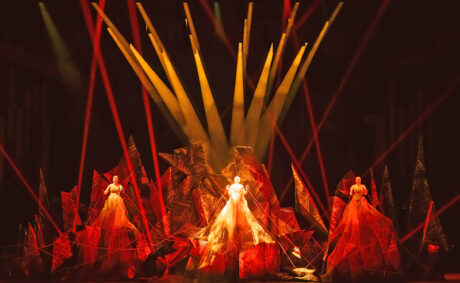
Claypaky Xtylos Wrap Up Wagner’s Ring Cycle for the Finnish National Opera
Designer Mikki Kunttu brought Richard Wagner’s epic Der Ring des Nibelungen, also known as the Ring cycle, to a breathtaking conclusion at the Finnish National Opera with the performance of the monumental, nearly six-hour-long Götterdämmerung featuring Claypaky Xtylos, the laser-based beam lighting fixture. The first installment of the Ring cycle, Das Rheingold, was performed at the Finnish National Opera in August and September 2019. The Covid pandemic delayed the second opera, Die Walkure, until autumn 2022, with performances of Siegfried following in March and April 2023.
The Ring’s lighting, sets and visuals were designed by Kunttu. He has worked mainly in the field of dance, but also in theater, popular music, opera, television and industrial arts. Kunttu has partnered with many prominent dance artists and groups from Finland and abroad and has collaborated repeatedly with the Finnish National Opera and Ballet, Norwegian National Ballet, Royal Danish Ballet and The Boston Ballet.
Kunttu chose Claypaky Xtylos fixtures for their unique laser light source. “Xtylos delivered the laser-type light beam that I wanted for visual effects,” he says. The Xtylos was first shown in the U.S. at LDI 2019 and has generated a lot of excitement in the entertainment lighting world. The compact, light-weight fixture produces dense, ultra-concentrated light beams in any color desired, offers instant color changing, additive color mixing and superior pan/tilt speed— features designed to provide lighting designers, lighting directors and creative stage teams with unique looks for special shows, such as the Ring. For Götterdämmerung, Kunttu positioned the Xtylos on dollies on the floor where they proved to be “excellent fixtures for this application,” he reports. The Xtylos were provided by rental company Woodlite Sweden AB.


